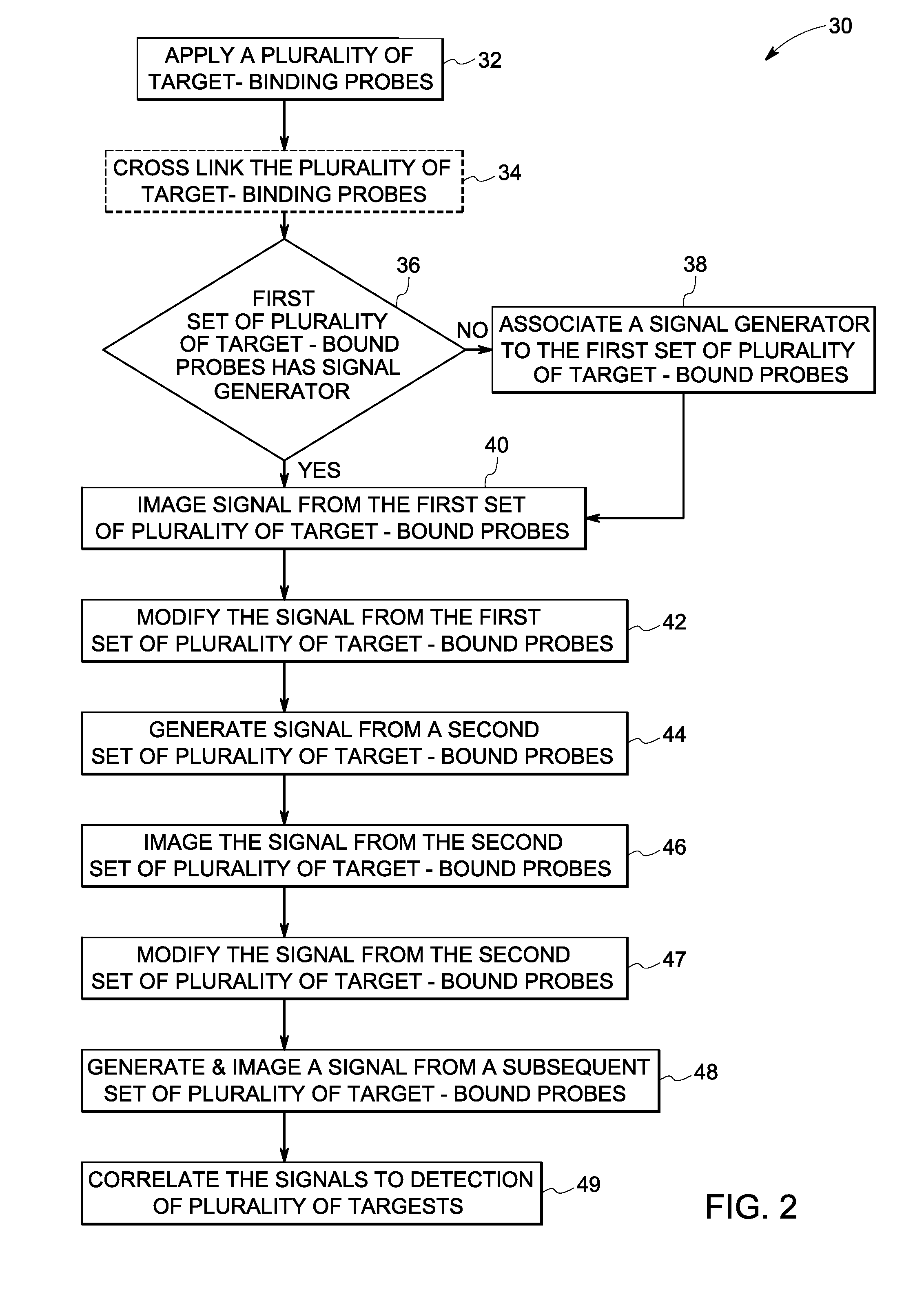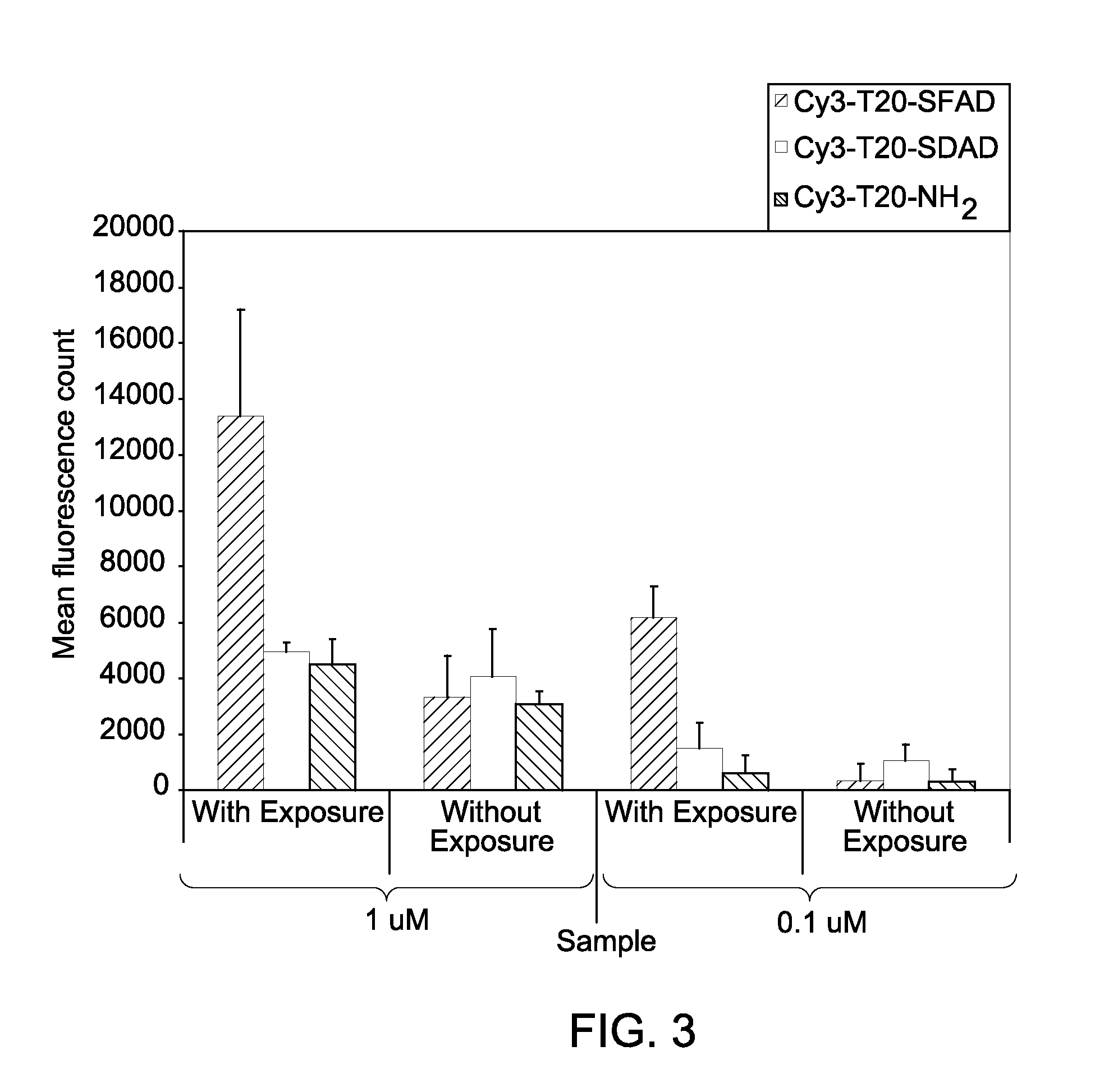Sequential analysis of biological samples
a sequencing analysis and biological sample technology, applied in the field of sequencing analysis of biological samples, can solve the problems of limited detection of limited number of targets that are accurately detectable in a single tissue sample during immunofluorescence assay, and inability to detect multiple targets in a single biological sample, etc., to achieve accurate determination of relative characteristics
- Summary
- Abstract
- Description
- Claims
- Application Information
AI Technical Summary
Benefits of technology
Problems solved by technology
Method used
Image
Examples
example 1
[0094]The cross-linker modified, cyanine dye-labeled, DNA oligomer, Cy3-T20-SFAD (SEQ. ID. NO: 1) was synthesized as follows. A 10 μL (31.9 nmoles) solution of Cy3-T20-NH2 (a thymidine oligomer comprising 20 thymidine units that is labeled with an amino modified linker at the 3′-end and labeled with a Cy3™ dye at the 5′-end, obtained commercially from Integrated DNA technologies, USA) in 10×PBS (Phosphate buffered saline) was diluted with 80 μL water and 10 μL of 1M NaHCO3 / Na2CO3 buffer (pH 8.4). To this, a 10 mM DMSO solution (20 equivalents) of sulfosuccinimidyl-[pentafluoroazidobenzamido]ethyl-1,3-dithiopropionate (Sulfo-SFAD, obtained commercially from ThermoFisher Scientific Inc., IL, USA.) was added. The mixed solution was stirred at room temperature for about 1-2 hours. The crude mixture was purified on NAP-10 column (GE Healthcare, USA) using protocol provided by the column supplier.
[0095]Sulfo-SFAD is a heterobifunctional cross-linker that contains an amine reactive sulfo-N...
example 2
[0096]The cross-linker modified, cyanine dye-labeled, DNA oligomer, Cy3-T20-SDAD (SEQ. ID. NO: 2) was synthesized as follows. A 10 μL (31.9 nmol) solution of Cy3-T20-NH2 (a thymidine oligomer comprising 20 thymidine units that is labeled with an amino modified linker at the 3′-end and labeled with a Cy3™ dye at the 5′-end, obtained commercially from Integrated DNA technologies, USA) in 10×PBS (Phosphate buffered saline) was diluted with 80 μL water and 10 μL of 1 M NaHCO3 / Na2CO3 buffer (pH 8.4). To this, a 10 mM aqueous solution (20 equivalents) of sulfosuccinimidyl 2-([4,4′-azipentanamido]ethyl)-1,3′-dithiopropionate (Sulfo-SDAD, obtained commercially from ThermoFisher Scientific Inc., IL, USA.) was added. The mixed solution was stirred at room temperature for 1-2 hours. The crude mixture was purified on NAP-10 column (GE Healthcare, USA) using protocol provided by the column supplier.
[0097]Sulfo-SDAD is a heterobifunctional cross-linker that contains an amine reactive sulfo-N-hydr...
example 3
[0098]The cross-linker modified, cyanine dye-labeled, DNA oligomer, Cy3-T20-SANPAH (SEQ. ID. NO: 3) was synthesized as follows. A 10 μL (31.9 nmol) solution of Cy3-T20-NH2 (a thymidine oligomer comprising 20 thymidine units that is labeled with an amino modified linker at the 3′-end and labeled with a Cy3™ dye at the 5′-end, obtained commercially from Integrated DNA technologies, USA) in 10×PBS (Phosphate buffered saline) was diluted with 80 μL water and 10 μL of 1M NaHCO3 / Na2CO3 buffer (pH 8.4). To this, a 20 mM aqueous solution (50 equivalents) of N-sulfosuccinimidyl-6-(4′-azido-2′-nitrophenylamino) hexanoate (Sulfo-SANPAH, obtained commercially from ThermoFisher Scientific Inc., IL, USA.) was added. The mixed solution was stirred at room temperature for 1-2 hours. The crude mixture was purified on NAP-10 column (GE Healthcare, USA) using protocol provided by the column supplier.
[0099]Sulfo-SANPAH is water soluble, heterobifunctional cross-linker with a spacer arm length of 18.2 Å...
PUM
| Property | Measurement | Unit |
|---|---|---|
| thickness | aaaaa | aaaaa |
| thickness | aaaaa | aaaaa |
| thickness | aaaaa | aaaaa |
Abstract
Description
Claims
Application Information
 Login to View More
Login to View More - R&D
- Intellectual Property
- Life Sciences
- Materials
- Tech Scout
- Unparalleled Data Quality
- Higher Quality Content
- 60% Fewer Hallucinations
Browse by: Latest US Patents, China's latest patents, Technical Efficacy Thesaurus, Application Domain, Technology Topic, Popular Technical Reports.
© 2025 PatSnap. All rights reserved.Legal|Privacy policy|Modern Slavery Act Transparency Statement|Sitemap|About US| Contact US: help@patsnap.com



